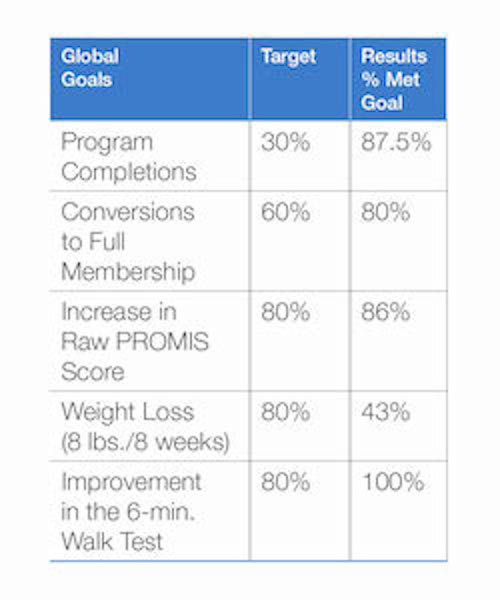contact & support
Toll Free: 877.888.2988
Main: 630.570.2600
Email: [email protected]

Roughly 57 million rural Americans – 15-20% of the population – endure health care disparities that are often worse than those living in urban or suburban markets. A complex mix of economic, social, racial, geographic and workforce factors in rural communities have limited access to healthcare and resulted in lower health outcomes. High fixed costs and low patient volumes challenge rural hospitals’ financial viability. As a result, in the past five years, 82 rural hospitals have closed, leaving residents without access to care and a major local employer.
Rural populations can benefit significantly from the presence of a medical fitness center, focused on older adults suffering from chronic conditions associated with age and lower socio-economic status (diabetes, obesity, heart disease, etc.). These populations are often geographically isolated without efficient access to health education and fitness services to help manage their chronic health conditions, outside of the physician office environment. Medical fitness centers also have a positive impact on the general population, providing health benefits associated with regular exercise in a conditioned environment. Often, rural communities lack any commercial fitness providers. Lastly, a medical fitness center builds social cohesion to combat isolation and creates economic viability with job creation.
Both rural hospitals and rural medical fitness centers can struggle with economic viability as a result of smaller populations and lower household incomes. However, Power Wellness has experience operating successful rural medical fitness centers that are financially self-sustaining, improve population health and that help drive economic development. In 2016, Power Wellness partnered with a single community healthcare provider in Louisiana to open a medical fitness center within a new ambulatory care center. The medical fitness center was programmed to help address issues identified in a community health needs assessment, whereby 22% of residents reported health as either fair or poor, and a high incidence of diabetes, heart disease and obesity.

Planning, development and management of a financially self-sustaining medical fitness center, particularly in a rural market, requires an understanding of appropriate physical spaces and efficient operating standards. In addition, building design must effectively integrate potential clinical services such as physician offices, outpatient rehabilitation, urgent care and diagnostic imaging among others, without compromising CMS reimbursement structures unique to rural health providers. A successful rural-based medical fitness center should focus on three key areas:

A core service at any of Power Wellness’s medical fitness centers is prescriptive fitness and special populations programming. These one-on-one or cohort-based programs integrate education, nutrition and/or fitness into traditional care pathways, often at the referral from a physician via an electronic health record. To be effective, these programs must be coordinated, integrated, measured, consistent and predictable. • Institution-wide Vision. Medical fitness center staff, along with hospital clinicians and local physicians must support the programs. Transparent clinical objectives help patients and staff follow best practices.
• Institution-wide Vision. Medical fitness center staff, along with hospital clinicians and local physicians must support the programs. Transparent clinical objectives help patients and staff follow best practices:
• Medical Advisory Committees. Physicians and clinicians provide program oversight to ensure quality, safety and outcomes:
• Technology Integration. Systems facilitate the secure and encrypted exchange of Protected Health Information (PHI) including physician referrals, health assessment data and participant utilization between provider electronic health records and medical fitness center operating systems:
Rural communities are often underserved by physicians and have “thin” specialist coverage due to their isolated location. Primary care physicians often have large practices and insufficient hours to appropriately handle patient volumes, in addition to significant travel times between clinic locations. This challenge is further compounded by many patients with chronic conditions. A medical fitness center can support these patient needs between clinic appointments with prescriptive fitness programs designed for individuals managing a chronic condition or a life-changing event i.e. pregnancy or total joint replacement. Early results indicate the following health improvements:

Some chronic medical conditions and illnesses endemic to rural populations such as diabetes, obesity, arthritis, smoking etc. are exacerbated by limited access to healthcare. A medical fitness center has potential to reduce the health disparities among rural communities. In addition to prescriptive fitness and special population programs, rural hospitals can leverage the medical fitness center to expand their portfolio of wellness services.
• Digital: Online classes or on-demand video can reduce barriers to access for rural populations that cannot easily attend in-person training or educational activities.
• Employer Wellness: Biometric screenings, on-site classes and occupational health assessments engage employees at their worksites to improve health, mitigate potential injuries and reduce sick leave.
• Unique Wellness Offerings: Subsidized indoor farmer’s markets, health technology learning “hubs” and healthy cooking classes promote healthy lifestyles.
Health Outcomes. Analysis from the Louisiana location indicates the following overall health improvements, based on 566 members whose key health metrics were re-assessed between 6 weeks and 18 months from their baseline assessment:
• Improved Branding. Rural hospital brand perception repositions a provider from sick care to health care:
• Community Support. High-quality wellness facilities may attract new businesses to a community. Families are more likely to put down roots in thriving and healthy communities, helping drive economic activity: